This is an old revision of this page, as edited by 74.248.93.105 (talk) at 08:56, 26 October 2009 (unscientific blog, not at all encyclopedic). The present address (URL) is a permanent link to this revision, which may differ significantly from the current revision.
Revision as of 08:56, 26 October 2009 by 74.248.93.105 (talk) (unscientific blog, not at all encyclopedic)(diff) ← Previous revision | Latest revision (diff) | Newer revision → (diff)| This article needs additional citations for verification. Please help improve this article by adding citations to reliable sources. Unsourced material may be challenged and removed. Find sources: "Hookah" – news · newspapers · books · scholar · JSTOR (February 2008) (Learn how and when to remove this message) |

A hookah (Template:Lang-hi, Template:Lang-ur hukkah), nargile in Turkish or shisha (Template:Lang-ar) is a single or multi-stemmed (often glass-based) water pipe for smoking shisha (a type of tobacco). Originally from India, hookah has gained immense popularity, especially in the Middle East and is gaining popularity in the USA, Canada, UK, and elsewhere. Today, some of the highest quality and most extravagant hookah pipes come from Egypt, Lebanon, Syria, Iran and Turkey. The hookah operates by water filtration and indirect heat. It is used for smoking fruits although some people have now used hookahs to smoke other items such as hashish or marijuana products.
Terminology

Often there is confusion with terminology. In the west, the device itself is referred to as a Hookah, and the tobacco/molasses is referred to as the Shisha. However, in the Arab world, the device itself is called a shisha (in reference to its glass base) and the tobacco is called moassel. Depending on locality, hookahs or Shishas may be referred to by many names: Arabic Language use it as Shisha or Nargeela or Argeela and they use it throughout the whole of the Arab World; Turkish people use it as Narghilè but pronounced "Argilah" is the name most commonly used in Turkey, Cyprus, Azerbaijan, Lebanon, and Syria. Narghile derives from the Persian word nārghile, meaning coconut, which in turn is from the Sanskrit word nārikela (नारिकेला), suggesting that early hookahs were hewn from coconut shells..
In Albania, Bosnia, Croatia the hookah is called "Lula" or "Lulava" in Romani, meaning "pipe," the word "shishe" refers to the actual bottle piece.
Shisha (شيشة), from the Persian word shīshe (شیشه), meaning glass, is the common term for the hookah in Egypt and the Arab countries of the Persian Gulf (including Kuwait, Iraq, Bahrain, Qatar, Oman, UAE, and Saudi Arabia), and in Morocco, Tunisia, Somalia and Yemen.
In Iran, hookah is called غلیون "Ghalyoon". In Uzbekistan, hookah is called "Chillim". In India and Pakistan the name most similar to the English hookah is used: huqqa (हुक्का /حقہ).
The commonness of the Indian word "hookah" in English is a result of the British Raj, the British dominion of India (1858–1947), when large numbers of expatriate Britons first sampled the water-pipe. William Hickey, shortly after arriving in Kolkata, India, in 1775, wrote in his Memoirs:
The most highly-dressed and splendid hookah was prepared for me. I tried it, but did not like it. As after several trials I still found it disagreeable, I with much gravity requested to know whether it was indispensably necessary that I should become a smoker, which was answered with equal gravity, "Undoubtedly it is, for you might as well be out of the world as out of the fashion. Here everybody uses a hookah, and it is impossible to get on without" have frequently heard men declare they would much rather be deprived of their dinner than their hookah.
History
The Hookah was invented in India in the court of the Mughal emperor Akbar (1542 - 1605 AD). Following the European introduction of tobacco to India, Hakim Abul Fateh Gilani a descendant of Abdul Qadir Al-Gilani came from Baghdad to India who was later a physician in the court of Mughal raised concerns after smoking tobacco became popular among Indian noblemen, and subsequently envisaged a system which allowed smoke to be passed through water in order to be 'purified'. Gilani introduced the hookah after Asad Beg, then ambassador of Bijapur, encouraged Akbar to take up smoking. Following popularity among noblemen, this new device from Arabia for smoking soon became a status symbol for the Indian aristocracy and gentry. The Indian Hookah was designed differently from the Arabian Hookah or Shisha which was invented during the Abbasid Empire in Baghdad. They were different in shape and design.
Culture
Middle East
Arab world
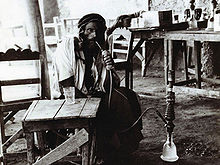
In the Arab world, people smoke it as part of their culture and traditions. Social smoking is done with a single or double hose, and sometimes even more numerous such as a triple or quadruple hose in the forms of parties or small get-togethers. When the smoker is finished, either the hose is placed back on the table signifying that it is available, or it is handed from one user to the next, folded back on itself so that the mouthpiece is not pointing at the recipient. It has been recorded that the Arabs are the biggest shisha smokers in the World and have the most shisha Cafes.
In cafés and restaurants, however, it is common for each smoker to order an individual hookah, as the price is generally low, ranging from USD 3 to USD 25.
Most cafés (Arabic: مقهىً, transliteration: maqhah, translation: coffeeshop) in the Middle East offer shishas. Cafés are widespread and are amongst the chief social gathering places in the Arab world (akin to public houses in Britain). Some expatriate Britons arriving in the Middle East adopt shisha cafés to make up for the lack of pubs in the region, especially where prohibition is in place.
Iran
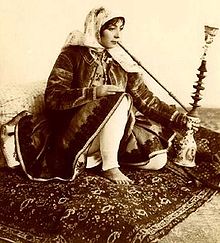
In Iran, the hookah is known as a ghalyun (Persian: قليان, قالیون, غلیون, also spelled ghalyan, ghalyaan or ghelyoon). It is similar in many ways to the Arabic hookah but has its own unique attributes. An example is the top part of the ghalyoun called 'sar' (Persian: سر=head), where the tobacco is placed, is bigger than the ones seen in Turkey. Also the major part of the hose is flexible and covered with soft silk or cloth while the Turkish make the wooden part as big as the flexible part.
Each person has his own personal mouthpiece (called an Amjid) (امجید), Amjid is usually made of wood or metal and decorated with valuable or other stones. Amjids are only used for their fancy look. However, all the Hookah Bars have plastic mouth-pieces.
Use of water pipes in Iran can be traced back to the Qajar period. In those days the hoses were made of sugar cane. Iranians had a special tobacco called Khansar (خانسار, presumably name of the origin city). The charcoals would be put on the Khansar without foil. Khansar has less smoke than the normal tobacco. Nasser al-Din Shah Qajar, Shah of Persia (1848-1896) is reputed to have considered a hookah mouthpiece pointed at him an insult.
The smoking of hookahs is very popular with young people in Iran, and many young people can be seen smoking them in local tea shops.
The hookah was, until recently, served to all ages; Iranian officials have since passed a law forbidding its use by those under 20.
Israel

In Israel, smoking hookah is not only a tradition, but culture. Hookah is prevalent among Middle Eastern Jewish immigrants from Iran, Iraq, Turkey and Yemen (collectively known as Mizrahi Jews). Hookah use is also common in the Arab home where families will commonly smoke after a large meal or at a family gathering. Hookahs are becoming increasingly popular within Israel particularly among tourists. Shops selling paraphernalia can be found on most high streets and markets. In 2005, due to an increase in use among youth, a campaign was launched by The Israel Cancer Association warning against the hazards of hookah smoking, and the IDF has forbidden the use of hookahs by soldiers within its bases.
South Asia
India


The concept of hookah originated In India, once the province of the wealthy, it was tremendously popular especially during Mughal rule. The hookah has since become less popular; however, it is once again garnering the attention of the masses, and cafés and restaurants that offer it as a consumable are popular. The use of hookahs from ancient times in India was not only a custom, but a matter of prestige. Rich and landed classes would smoke hookahs. Tobacco is smoked in hookahs in many villages as per traditional customs. Smoking molasses in a hookah is now becoming popular amongst the youth in India. It is a growing trend amongst youngsters and adolescents. There are several chain clubs, bars and coffee shops in India offering a variety of hookahs. The new trends emerging are that of non-tobacco hookahs with herbal flavors.
Koyilandy, a small fishing town on the west coast of India, once made and exported these extensively. These are known as Malabar Hookhas or Koyilandy Hookahs. Today these intricate hookahs are difficult to find outside of Koyilandy and not much easier to find in Koyilandy itself. The government looks down on hookah smoking. There have been numerous raids and bans recently on hookah smoking, especially in Gujarat
Pakistan
In Pakistan, although traditionally prevalent in rural areas for generations, hookahs have become very popular in the cosmopolitan cities. Many clubs and cafes are offering them and it has become quite popular amongst the youth and students in Pakistan. This form of smoking has become very popular for social gatherings, functions, and events. There are a large number of cafes and restaurants offering a variety of hookahs. Karachi has seen a growth in this business.
Southeast Asia
Philippines
In the Philippines, the Hookah or Shisha was particularly used within the minority Arab Filipino communities and Indian Filipino, although particularly among indigenous Muslim Filipinos, a historical following of social and cultural trends set in the Middle East led to the Hookah being a rare albeit prestige social-habit of noblemen in important trade cities such as Cotabato or Jolo.
Hookah was virtually unknown by Christian Filipinos before the latter 20th century, yet the popularity among contemporary younger Christians is now vastly growing. In the capital's most cosmopolitan city, Makati; various high-end bars and clubs offer hookahs to patrons.
Although hookah use has been common for hundreds of years and enjoyed by people of all ages, it has just begun to become a youth-oriented pastime in Asia in recent times. Hookahs are most popular with college students and young adults, who may be underage and thus unable to purchase cigarettes.
South Africa
In South Africa, hookah, colloquially known as a hubbly bubbly or an okka pipe, is popular amongst the Cape Malay and Indian populations, wherein it is smoked as a social pastime. However, hookah is seeing increasing popularity with white South Africans, especially the youth. Bars that additionally provide hookahs are becoming more prominent, although smoking is normally done at home or in public spaces such as beaches and picnic sites.
In South Africa, the terminology of the various hookah components also differ from other countries. The clay "head/bowl" is known as a "clay pot". The hoses are called "pipes" and the air release valve is known, strangely, as a "clutch".
Some scientists point to the dagga pipe as an African origin of hookah
United States and Canada
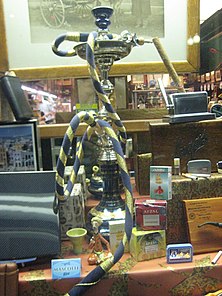
Recently many cities, states and counties have implemented indoor smoking bans. In some jurisdictions, hookah businesses can be exempted from the policies through special permits. Some permits however, have requirements such as the business earning a certain minimum percentage of their revenue from alcohol or tobacco.
In cities with indoor smoking bans, hookah bars have been forced to close or consider alternatives, such as offering flavored tobacco based maasel. In many cities though, hookah lounges have been growing in popularity. From the year 2000 to 2004, over 200 new hookah cafes opened for business, most of which are targeted at a young-adult age group, and were particularly near college campuses or cities with large Middle-Eastern communities. This activity continues to grow in popularity within the post-secondary student demographic.
In North America, the term 'shisha' is not as commonly used as 'hookah'. Sometimes 'Shisha' can also refer to the Flavored Tobacco inside the pipe as opposed to the Hookah pipe itself. It's important to note that in the middle east a "hookah" pipe does not have a hose-it only incorporates the straight neck.
Structure and operation
Components
Excluding grommets, a hookah is usually made of five or six components, four of which are essential for its operation.
The bowl
Also known as the head of the hookah, the bowl is a container, usually made out of clay or marble, that holds the coal and tobacco during the smoking session. The bowl is loaded with tobacco then covered in a small piece of perforated tin foil or a glass or metal screen. Lit coals are then placed on top, which allows the tobacco to heat to the proper temperature.
There is also a variation of the head which employs a fruit rather than the traditional clay bowl. The fruit is hollowed out and perforated in order to achieve the same shape and system a clay bowl has, then it is loaded and used in the same manner.
Windscreen (optional)
A windscreen is a cover which sits over the bowl area, with some form of air holes. This prevents wind from increasing the burn rate and temperature of the coal, and prevents ash and burning embers from being blown onto the surrounding environment. This may also offer some limited protection from fire as it may prevent the coal from being ejected if the hookah is bumped.
Hose
Technically speaking, if the pipe has a hose it is not "hookah"-hookah refers to a straight-neck tube. The hose is a slender tube that allows the smoke to be drawn. The end is typically fitted with a metal, wooden, or plastic mouthpiece, and come in various shapes, sizes, colours and material type
Body and gaskets
The body of the hookah is a hollow tube. The bowl is attached to the top. Sometimes an ice bucket is attached between the body and the bowl to cool the smoke. At the bottom is a thin tube (the downstem) that is submerged in water. The point where the body meets the water jar is sealed with a gasket. Near there are at least two holes that open into the space above the water. One or more may accept a hose.
Purge valve (optional)
Many hookah are equipped with a purge valve connected to the airspace in the water jar to purge stale smoke which has been sitting unused in the jar for too long. This one-way valve is typically a simple ball bearing sitting over a port which seals the port by gravity alone and will open if positive pressure is created by blowing into the hose. The bearing will be held captive with a screw-on cover. The cover should be opened and the bearing and seat cleaned of residue and corrosion regularly to ensure proper sealing.
Water jar
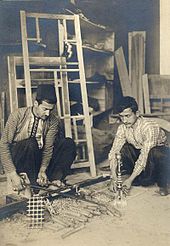
The body of the hookah sits on top of the water jar. The downstem hangs down below the level of the water in the jar. Smoke passes through the body and out the downstem where it bubbles through the water. This cools and humidifies the smoke. Liquids such as fruit juice may be added to the water or used in substitution. Pieces of fruit, mint leaves, and crushed ice may also be added.
Plate
A plate or ashtray sits just below the bowl to catch ashes falling off the coals.
Grommets
Grommets in a hookah are usually placed between the bowl and the body, the body's gasket and the water jar and between the body and the hose. The reason for the usage of grommets although not essential (the use of paper or tape has become common) will help to seal the joints between the parts, therefore decreasing the amount of air coming in and maximizing the smoke breathed in.
Operation
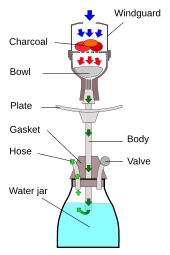
The jar at the bottom of the hookah is filled with water sufficient to submerge a few centimetres of the body tube, which is sealed tightly to it. Deeper water will only increase the inhalation force needed to use it. Tobacco is placed inside the bowl at the top of the hookah and a burning charcoal is placed on top of the tobacco. Some cultures cover the bowl with perforated tin foil or a metal screen to separate the coal and the tobacco, which minimizes inhalation of coal ash with the smoke. This may also reduce the temperature the tobacco is exposed to, in order to prevent burning the tobacco directly.
When one inhales via the hose, air is pulled through the charcoal and into the bowl holding the tobacco. The hot air, heated by the charcoal evaporates (not burns) the tobacco, thus producing smoke, which is passed down through the body tube that extends into the water in the jar. It bubbles up through the water, losing heat, and fills the top part of the jar, to which the hose is attached. When a smoker inhales from the hose, smoke passes into the lungs, and the change in pressure in the jar pulls more air through the charcoal, continuing the process.
If the hookah has been lit and smoked but has not been inhaled for an extended period, the smoke inside the water jar may be regarded as "stale" and undesirable. Stale smoke may be exhausted through the purge valve, if present. This one-way valve is opened by the positive pressure created from gently blowing into the hose. It will not function on a multiple-hose hookah unless all other hoses are plugged.
Health risks
The health risks associated with hookah usage are still relatively unstudied when compared to those of cigarettes or other means of tobacco consumption. A common belief among younger users is that the smoke is significantly less dangerous than that from cigarettes. The water moisture induced by the hookah makes the smoke less irritating and may give a false sense of security and reduce concerns about true health effects. Doctors at institutions including the Mayo Clinic have stated that use of hookah can be as detrimental to a person's health as smoking cigarettes, and a controversial (see below) study by the World Health Organization also confirmed these findings.
Each hookah session typically lasts more than 40 minutes, and consists of 50 to 200 inhalations that each range from 0.15 to 0.50 liters of smoke.
A study in the Journal of Periodontology found that water pipes smokers were five times more likely than non-smokers to show signs of gum disease. People who smoked water pipes had five times the risk of lung cancer as non-smokers.
Furthermore, the water used to filter the chemicals does not work efficiently to remove all the harmful chemicals. One single session (45-minutes) of Hookah smoking will result in the smoker breathing in 100 times more smoke than regular smoking.
According to additional reports by the World Health Organization and the American Cancer Society shown that, in a one-hour hookah session, users consume about 100 to 200 times the smoke and about 70 times the nicotine as they do in one cigarette.
In a Pakistani article examining the levels of carinoembryonic antigen CEA, a marker found in several forms of cancer, in hookah users, levels in exclusive hookah smokers were low compared to cigarette smokers although the difference was not statistically significant. Nevertheless, they study concluded heavy hookah smoking substantially raises CEA levels. . This study was published in the Harm Reduction Journal, a peer-reviewed scientific journal of the BioMed Central Group.
References
- "Smoky desires: get the hookah up from several local lounges". The Stanford Daily. Retrieved 2008-04-08.
- "Beyond the Smoke, There is Solidarity Among Cultures". Victoria Harben for Common Ground News Service. Retrieved 2008-12-05.
- "Metro Detroit's Hookah Scene". Terry Parris Jr for Metromode Media. Retrieved 2008-12-27.
- "Hookah History". Colors of India. Retrieved 2008-12-05.
- Rousselet, Louis (2005) . "XXVII - The Ruins of Futtehpore". India and Its Native Princes: Travels in Central India and in the Presidencies of Bombay and Bengal (in English - UK) (Reprint - Asian Educational Services 2005 ed.). London: Chapman and Hall. p. 290. ISBN 8-1206-1887-4.
{{cite book}}: CS1 maint: unrecognized language (link) - "Hookah". Encyclopædia Britannica. Retrieved 2008-04-08.
- "Nargile". mymerhaba.
- Memoirs of William Hickey (Volume II ed.). London: Hurst & Blackett. 1918. p. 136.
- ^ Sivaramakrishnan, V. M. (2001). Tobacco and Areca Nut. Hyderabad: Orient Blackswan. pp. 4–5. ISBN ISBN 8125020136.
{{cite book}}: Check|isbn=value: invalid character (help); Cite has empty unknown parameter:|coauthors=(help) - Blechynden, Kathleen (1905). Calcutta, Past and Present. Los Angeles: University of California. p. 215.
- ^ Rousselet, Louis (1875). India and Its Native Princes: Travels in Central India and in the Presidencies of Bombay and Bengal. London: Chapman and Hall. p. 290.
- "Origins". Article Niche History of Hookah.
- "Hookah". Indian Express. Retrieved 2008-06-08.
- Use of Cigarettes and Other Tobacco Products Among Students Aged 13-15 Years - Worldwide, 1999-2005
- Hubble-bubble as cafes go up in smoke
- "The Mysterious Origins of the Hookah (Narghile) The Sacred Narghile
- Lyon, Lindsay "The Hazard in Hookah Smoke". (28 January 2008)
- http://www.zichi.com/article.asp?id=10 (Assembly/Maintenance Diagram)
- Barry Knishkowy and Yona Amitai (2005). "Water-Pipe (Narghile) Smoking: An Emerging Health Risk Behaviour". Pediatrics; journal of the American Academy of Pediatrics.
{{cite journal}}: Cite journal requires|journal=(help) - Hookah smoking: Is it safer than cigarettes? - MayoClinic.com
- Water pipe smoking a significant TB risk - IRIN News, March 2008
- Egyptians warned on pipe smoking | The Australian
- Alan Shihadeh, Sima Azar, Charbel Antonios, Antoine Haddad (September, 2004). "Towards a topographical model of narghile water-pipe café smoking: a pilot study in a high socioeconomic status neighbourhood of Beirut, Lebanon". Elsevier Pharmacology Biochemistry and Behavior, Volume 79, Issue 1. doi:10.1016/j.pbb.2004.06.005.
{{cite journal}}: Check date values in:|date=(help); Cite journal requires|journal=(help)CS1 maint: multiple names: authors list (link) - Mirjana V. Djordjevic, Steven D. Stellman, Edith Zang (January 19, 2000). "Doses of Nicotine and Lung Carcinogens Delivered to Cigarette Smokers". Journal of the National Cancer Institute, Vol. 92, No. 2. doi:10.1093/jnci/92.2.106.
{{cite journal}}: Check date values in:|date=(help); Cite journal requires|journal=(help)CS1 maint: multiple names: authors list (link) - "Hookah trend is puffing along". USA Today. December 28, 2005.
{{cite journal}}: Check date values in:|date=(help); Cite journal requires|journal=(help) - "WHO warns the hookah may pose same risk as cigarettes". USA Today. May 29, 2007.
{{cite journal}}: Check date values in:|date=(help); Cite journal requires|journal=(help) - "Hookah smoking poses health risks". Rocky Mountain Collegian. November 20, 2008.
{{cite journal}}: Check date values in:|date=(help); Cite journal requires|journal=(help) - "Hookah smoking and cancer: carcinoembryonic antigen (CEA) levels in exclusive/ever hookah smokers". Harm Reduction Journal. May 24, 2008.
{{cite journal}}: Check date values in:|date=(help); Cite journal requires|journal=(help)
External links
- The Sacred Narghile, a non-commercial site containing transdisciplinary anthropological (including on origins) and biomedical information and discussions of the above cited scientific studies
- WHO Report on water pipe (hookah), by WHO Study Group on Tobacco Product Regulation (TobReg).
- Critique of the WHO Report on water pipe (hookah) by Chaouachi Kamal. A Critique of WHO's TobReg "Advisory Note" titled: "Waterpipe Tobacco Smoking: Health Effects, Research Needs and Recommended Actions by Regulators. Journal of Negative Results in Biomedicine 2006 (17 Nov); 5:17 (Highly Accessed)
- Scientific Evidence of the Health Risks of Hookah Smoking (University of Maryland, College Park: June 9, 2008, vol 17, issue 23